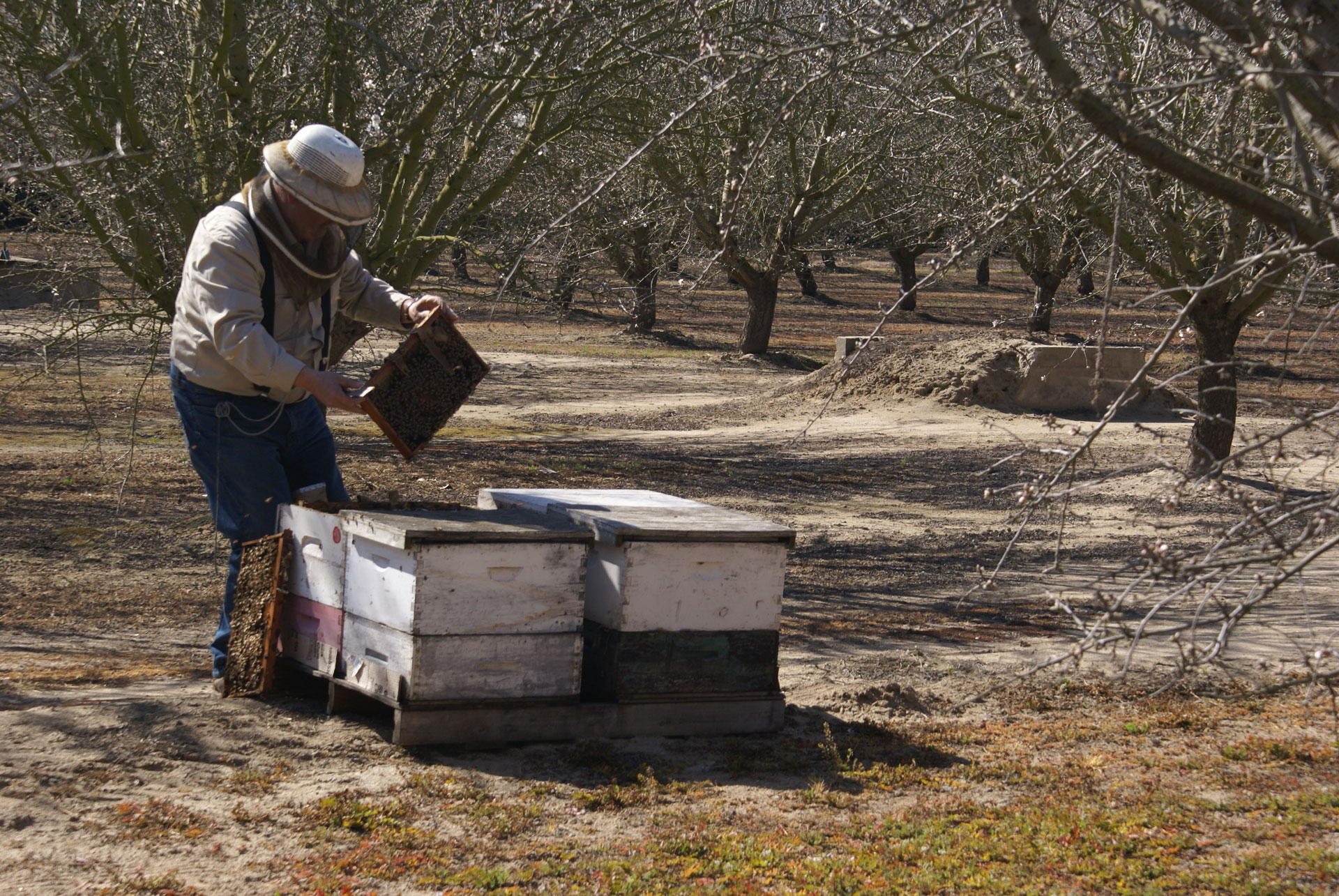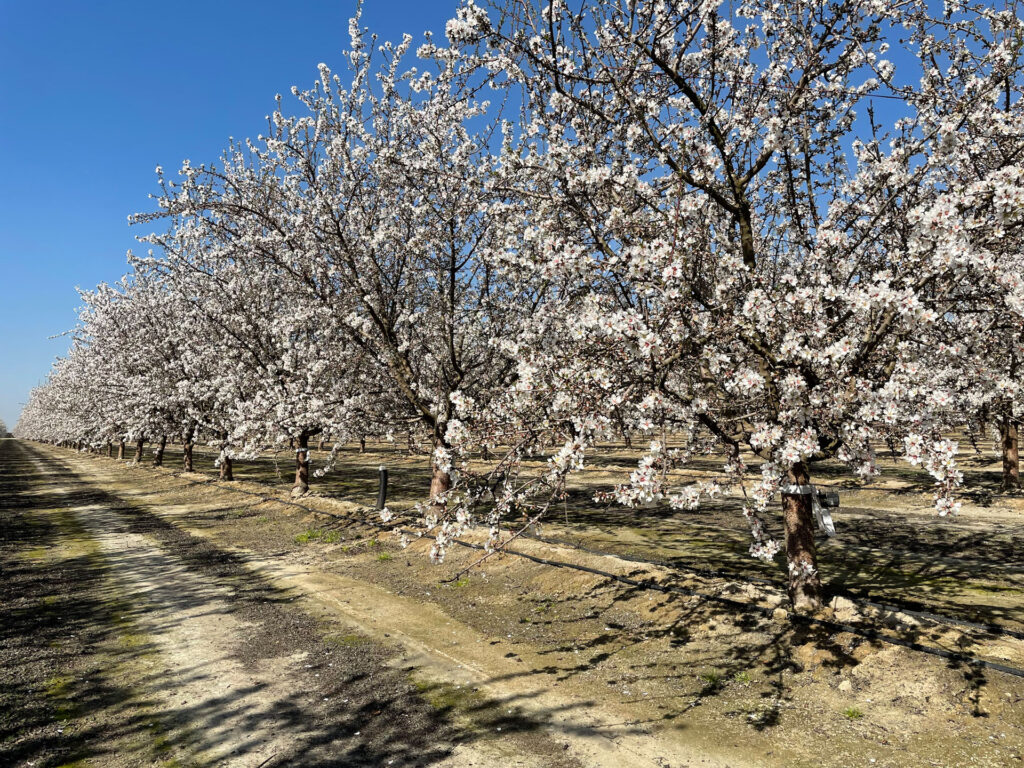
Harvest is over. Mummies are shaken and swept. Is it time to think about almond pollination?
According to bee brokers and beekeepers, tighter supplies this year and increasing demand for pollination services mean almond growers need to contract for hives early and plan ahead for their arrival in the orchards.
New Era of Pollinator Contracts
Denise Qualls, a bee broker with Pollination Connection, said contracts with growers are welcomed sooner rather than later to ensure an adequate honeybee supply. Some almond growers do book early, she said, but for the most part, growers don’t think about bees until after harvest. Many contracts are signed in December and January, but bees are still being booked in February.
Qualls said the days of a handshake to secure pollination service might be over.
“Most growers and brokers now have written contracts that spell out terms for pollination services including price, delivery time and hive strength,” Qualls said. Conditions spelled out in the contract can ensure the grower receives the pollination service necessary for setting a crop. The contract also can ensure beekeepers are fairly compensated for their time and investment in healthy, strong hives.
Verbal agreements worked back when hives were renting for less than $100 and far fewer acres of almonds were grown. Now, Qualls said, demand for strong hives to cover all almond ground in the state requires that both sides agree on exact terms and put them in writing.
Josette Lewis, chief scientific officer with Almond Board of California said ABC recommends growers sign contracts for pollination service. There needs to be clear understanding and communication between the growers and beekeeper. A sample contract is available at ABC’s website.
Number of full frames per hive is a key element in a contract, Lewis said. A third party inspector can verify the hive strength for the grower. County Agricultural Commissioners’ offices should provide inspector information.
Working Together
Steve House, director of operations at California Almond Pollination Service, said once a grower finds a good beekeeper and a beekeeper finds a good grower, they each have an integral component in their supply chain and a major factor in the success of their businesses. Both parties need to understand the success of one depends on the success of the other.
In addition to costs, hive numbers and arrival time, House said beekeepers need to know if the hives will be secure from theft, if pesticide applications will be made, if there is a water supply and the timing of payments.
Important considerations for almond growers are hive strength and confirmation of arrival time in the orchard, generally no later than 5% bloom.

Almond growers depend on strong, healthy hives that have at least six frames of bees and an average of eight frames of bees at the beginning of bloom.
Hives that lack these frame minimums have very little ‘field force,’ House said, and do very little pollinating. It would take seven to eight four-frame hives to equal one eight-frame hive. House explained that the numbers in the hives keep the hive warm and take care of the queen and the brood. An eight-frame hive has a field force of about 6,400 bees that actively go out to collect pollen, nectar and water. A four-frame hive will have only about 800 bees living in the hive.
That is the reason hive inspection and grading is recommended, House and Qualls agreed.
“It’s like paying for 1,000 gallons of fuel and receiving only 800 gallons,” House said.
About 15% of the hives should be inspected. An apiary inspector can conduct the inspection and growers should observe. An inspection will determine if the terms stated in the grower/beekeeper agreement are being met.
The Almond Board of California Honey Bee BMPs noted that growers should be sure to notify the beekeeper of the inspection so they can assist in handling the hives. It is best to let the hives acclimate to the orchard landscape before conducting the inspection.
Colony strength evaluations not only help ensure growers get what they pay for, they also help ensure that beekeepers are compensated for additional expenses in providing
quality hives.
Growers can further monitor colony strength by walking orchards daily during bee flight hours to observe activity levels. When walking orchards during bee flight hours, growers should look for bees carrying pollen on their legs, which confirms that pollination is taking place. In addition, growers should record hives that appear weak, having few bees coming and going at the hive entrance during the day, or inactive, and then report those hives to the beekeeper.
Other Considerations
Qualls noted that bee supplies remain tight. If beekeepers can keep winter losses under 40%, there should be adequate numbers. She said losses were only anticipated to be in the 25% to 30% range this year. Varroa mites, drought and lack of native forage have had negative effects on hive strength, she said, and beekeepers have higher costs in maintaining healthy hives.
She noted that as demand for pollination services has increased, higher prices will likely follow, though they have held steady at $200 to $210 for the last two years. Hives priced at lower rates may mean beekeepers haven’t made the effort needed to control varroa mites, Qualls said.
Rising costs for inputs and the ongoing drought have been hard on both almond growers and beekeepers this year, Lewis said. When it comes to pricing information for pollination, Lewis said California State Beekeepers Association generally surveys beekeepers at their annual meeting and then publishes that information.
Besides frame and grading requirements, House said other important contract points are number of hives delivered, delivery date, price per hive and payment schedule. Pesticide applications when bees are present in the orchard can also be part of the contract.
The pest management plan for the orchard should be shared with beekeepers to make them aware of the products that may be used, Lewis said. Beekeepers are asked to register their sites with the county, but it is also important that they relay contact information to PCAs. Who will change water after a pesticide application should also be specified.
“Both growers and beekeepers should have a clear understanding of the elements of the contract,” Lewis said.










